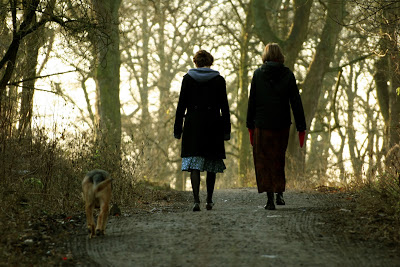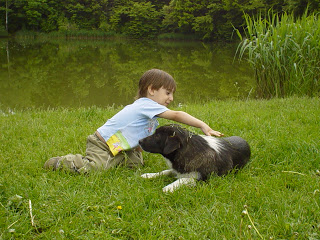“I keep the telephone of my mind open to peace, harmony, health, love and abundance. Then, whenever doubt, anxiety or fear try to call me, they keep getting a busy signal—and soon they’ll forget my number.” ~ Edith Armstrong
Monthly Archives: April 2011
5-Minute Courage Workout: It’s a Dog Eat Dog World!
No matter where you live in the world, dogs are either your best friend or a wildly roaming neighbor you and your child need to learn how to be brave around. As much as dogs can provide much love, exercise, and entertainment to our lives, it is wise to remember that they are predators and certain human behaviors can trigger their prey drive. Local customs and beliefs about dogs vary around the world, but dog behavior is universal.
- Toddler: reading books together and pointing out all the doggies, practicing your own unique barks, and learning how to safely pet a dog is the perfect place to start teaching your toddler about dogs. The next time you are visiting friends with a dog, or walking around the neighborhood, spending five minutes teaching your child that it is up to you as his/her parent when/if your child gets to pet the doggie. First, ask the owner “Is your dog child-friendly? Would it be okay if I pet your dog?” If the owner says “No!” heed the owner’s caution wisely. Wide-berth the dog and carry on. Be aware that toy breeds are most appealing to small children, but also most likely to be fearful and/or jump up and startle your toddler. As much as possible, you want your child’s first introduction to the dog world to be with a larger, gentle dog (e.g. Lab, Newfie, Retriever). When you have the owner’s “OK”, tell your child “Mommy’s going to pet the doggie. Watch what I do.” Keeping a safe distance between your child and the dog, perhaps even holding your child’s hand at your side with your body between your child and the dog. Show your child how you make your other hand into a fist and offer it for the dog to smell. Say to your child “This is how a doggie gets to know us, by taking a sniff.” Little fingers not rolled into a fist make for sausage-like looking treats to most dogs. Once you are confident in the dog’s friendly nature, you can then model for your child how to pet the dog in the middle of it’s back. If your child is curious, have them form their own hand into a fist and allow the dog to smell or lick your toddler’s hand and then pet the doggie gently with your help so their body remembers what gentle touch feels like.
- Preschooler: preschoolers love to squeal, squirm, and jump around like fun prey or playmates for most dogs. Modeling a calm demeanour for your child to emulate around dogs will be important at this stage. Quietly standing tall with hands at your side, for example, will help show your child to adopt the pack leader posture. The next time you encounter a dog you don’t know, spend five minutes practicing how to stand still, look away, and fold your arms across your chest until the dog has passed. Showing your child how to be confident in a potentially threatening situation helps them develop the same confidence. Reassure your child that most dogs, after they have had a sniff, will move on especially when we stay calm.
- Early elementary student: make a doggie playdate with a friend, neighbor, or family member who owns a reasonably well-trained dog. The goal here is for your child to have at least one five-minute opportunity to learn how to give a dog a command and have success being assertive with a dog. “Sit” is a great command to start with, it levels the playing field quickly between an early elementary student’s stature and an average-sized dog. The typical command for “Sit” involves either raising one hand slightly palm-side up or pointing with one finger to the ground. Have the dog’s owner model the command first. Again, ensuring your child uses a lower-pitched voice, stands tall, and doesn’t wiggle around nervously when issuing the command will be important. Each command is meant to be issued once, followed either with a treat or praise, and not to be repeated over and over again without success. If a treat is rewarded, ensure that your child offers it on a flat palm, fingers tight together.
- Upper elementary student or ‘tween: if you’ve been practicing courage workouts with your child and he/she has learned to navigate the neighborhood independently (maybe even with your own family dog), your child is now likely to encounter a dog without you nearby. It could be a dog on a leash, in that case they now know how to ask the owner before approaching or interacting with the dog. If it is an unleashed dog, teach your child not to interact and how to assess the degree of threat. Discuss with your child what threatening gestures from a dog look like: fur up on their backs, exposed snarling teeth, growling, ears forward, head lowered, and tail held stiffly. Review a checklist with your child about how to keep themselves safe around an aggressive dog in your neighborhood. This list could include the following: walk don’t run to the nearest safe house, climb a fence, pick up a stick to distract or keep the dog at a safe distance. Take a five-minute walk through the neighborhood together to assess any hot spots in your ‘hood and practice what to do.
- High schooler or teen: It is rare to get to the teen years without at least one scary run-in with a dog. Take five minutes to review what your teen actually knows about how to deal with dogs. Ask your teen if there have been any dog incidents recently that you don’t know about, and find out what happened and what choices he made. Ask how he knew to do what he did, and spend a few minutes reviewing what some of the other options might have been. Offer kudos for a job well done (after all, his limbs are still intact). Share a scary dog story from your own experience, (or that of someone you know) to highlight what your options were, how you showed courage in the moment, and what you learned about how to deal with dogs. The more opportunities we have to rehearse scenarios, the better prepared we are when the situation bares its teeth at us.
Want more workouts? Here’s our 5-Minute Courage Workout: A Fate Worse Than Death (on public speaking), our 5-Minute Courage Workout: Home Alone, our 5-Minute Courage Workout: Talking Dirty, our 5-Minute Courage Workout: Playing with Fire, 5-Minute Workout on Saying I’m Sorry, or our 5-Minute Courage Workout: Navigating the Neighborhood
We’d love to hear about your results with one of these workouts, or share your own!
Deeper into the Enchanted Woods We Go
“It is characteristic of fairy tales to state an existential dilemma briefly and pointedly. This permits the child to come to grips with the problem in its most essential form, where a more complex plot would confuse matters for him. The fairy tale simplifies all situations. Its figures are clearly drawn, and details, unless very important, are eliminated. All characters are typical rather than unique.”
 On the other hand, fairy tales offer not characters but situations, the existential dilemmas of the above Bettelheim excerpt. We don’t want real-seeming characters in them, because we want to inhabit them ourselves, for a while. The “characters” in fairy tales are more like masks that we can try on to see how it feels. We don’t really know much of anything about Cinderella’s personality, but we can try on what it feels like to be rejected and excluded and abused, and then rewarded.
On the other hand, fairy tales offer not characters but situations, the existential dilemmas of the above Bettelheim excerpt. We don’t want real-seeming characters in them, because we want to inhabit them ourselves, for a while. The “characters” in fairy tales are more like masks that we can try on to see how it feels. We don’t really know much of anything about Cinderella’s personality, but we can try on what it feels like to be rejected and excluded and abused, and then rewarded.“Today [1975!] children no longer grow up with the security of an extended family, or of a well-integrated community. Therefore, even more than at the time fairy tales were invented, it is important to provide the modern child with images of heroes who have to go out into the world all by themselves and who, although originally ignorant of the ultimate things, find secure places in the world by following their right way with deep inner confidence.”
Courage Quote of the Day
“Courage is the power to let go of the familiar. ”
~ Raymond Lindquist
The Flyaway Lake
In my mouth the words are melting
From my lips the tones are gliding
From my tongue they wish to hasten
When my willing teeth are parted
When my ready mouth is opened
Songs of ancient wit and wisdom
Hasten from me not unwilling
Golden friend, and dearest brother,
Brother dear of mine in childhood
Come and sing with me the stories
Come and chant with me the legends,
Legends of the times forgotten
Since we now are here together
Come together from our roamings…
~ the Kalevala
Let me open the painted box of stories, and tell you of a lake that did not like where it was or who befouled it, and so flew to a better place.
In Estonia, a northern land on the Baltic Sea with many islands, there was a lake, called Eim Lake. It was surrounded by woods, and legend said that the bottom of this lake was covered with golden treasure. People who would rather fish for treasure than work for pay often went out in boats, dredging for gold. When their efforts did not pay off, they took to waylaying travelers in the nearby woods, and robbing them. Over time the woods around this lake developed an evil reputation; the forest became dark and overgrown, and weeds and reeds choked the edges of the lake. No crops grew by its shores, nor cattle or sheep drank its waters. Before long the bandits were doing more than simply robbing the anxious travelers who had no choice but to pass through the woods; before long the bandits were killing them, and dumping their bodies into the lake. Eim Lake grew foul, and under sunset skies it was a dull, blood red. Trash and litter from the bandit camp on the lakeshore drifted here and there in the stagnant water. Geese would not fly over, nor land there.
One night, as the bandits lay sleeping in their tents, there was a sloshing, sucking sound. The lake was gathering itself and all its fish, and was lifting itself up, as a lady lifts her long skirts from the mud. Up it rose from its muddy, stagnant bed, leaving behind the filth of rot and death. The clear waters with rejoicing fish gathered into the air like a cloud, scattering a few drops onto the bandit-tents. The one look-out, holding out his hand for rain, glanced up. But the dark sky was pierced with stars – only one dark shape obscured them, and it was moving swiftly away. The overpowering odor of decat drew his attention to the lake bed, which was now a stinking trough of mud. “The lake has flown away!” he cried. “Now we can hunt for treasure on foot!”
The bandits waited until morning, and then trudged across the sucking mudflats, captivated by the sight of rotting chests and boxes. But when they reached the treasure caskets what did they find but only frogs and salamanders and snakes and eels, which wriggled after them, biting wetly and squirming into their pockets.
Meanwhile, the lake was traveling, looking for a place to land. Below was a dry, parched land, and the people stood with prayerful eyes turned to the skies. “A raincloud!” cried one child. “No, not a cloud,” said his father in amazement. “A floating lake of clear water! Please, come to us, lake!”
“Will you tend to me, and keep my shores free of weeds, and make birds welcome?” called the voice of the lake. “Make a place for me and I will dwell here.”
The people dug with everything they had, shovels, rakes, buckets, spoons, clearing away a clean bed for the lake. With the sound of steady rain, Eim Lake poured itself down into its new place. The grateful people tended the lake like a baby, and kept it clean, and built wooden docks and grazed their sheep there and let its waters nourish their crops. The land all around the lake became fruitful, and beautiful, and the people were filled to the rim with gratitude, as pouring water fills a cup.
This is an unusual story, isn’t it? It’s from the Kalevala, the ancient epic poem of Finland/Estonia. I’ve never before heard a story about a lake with opinions and made decisions, let alone got up and left, so this really caught my attention. You can read it as a metaphor for relationship, and observe that it takes emotional courage to leave a person or a job that has become abusive, and then be willing to try again somewhere new. But I also love that you can read this is a story about gratitude and good stewardship. Spiritual courage allows us to recognize and give thanks for all the natural gifts that make life possible and meaningful. May we have the courage to do our best at tending all our natural resources, lest they decide to fly away.
Courage Book Review – “I will stir up the waters of the old days and shape the long-ago then into now.”

Certainly, this ancient predecessor to so many popular stories (did someone say Lord of the Rings?) is one of the gold standards for physical courage tales. In an age when smiting and smashing were regular activities, this sort of courage was highly prized; of course the heroism of physical courage would be celebrated with poems and sagas. Along with physical courage, Beowulf also upholds honor in repaying debts of service, and in protecting the people in his care; we may call this moral courage.
What may make this classic important to share with kids today is precisely its super-hero, almost one-dimensional physical courage. This foundational piece of English literature may have helped to shape cultural ideas of what courage is, what heroism is. Do we see intellectual courage here? Spiritual courage? Social or emotional courage? No. But can stereotypes offer us a lens for examining our own ideas and beliefs? Yes. Like metaphors, another literary tool, stereotypes allow us to grapple with complex ideas and make meaning of our own experience.

, adapted by Nicky Raven. This is
illustrated by one of the lead artists from the Lord of the Rings movies, John Howe. The writing lacks the Anglo-Saxon punch of Rumford’s telling, but the obvious visual debt of LOR to Beowulf demonstrated in the art makes it an interesting companion to the Rumford book. Share these two with your kids, and follow up with a conversation about physical courage, and whether that’s the only kind of courage that makes a hero.
You might also enjoy Heaney’s translation for yourself, which includes the original text opposite the translation. Try reading it out loud for a vocal workout! You can almost understand these chewy words if you hear them spoken. Sit by a smoky fire in semi-darkness for the best effect!
A Spectrum of Attachment: Beth’s Story
“With my first child,” Beth explains, “I was so young, so immature. I didn’t know what I was doing. I had an emergency C-section, little time to bond during the first few hours’ post-op, little support upon our homecoming, and she was colicky during a summer heat wave! It was hard. I still have regrets.”
She continues, “My second child was way easier. I had a successful vaginal birth. My baby was so round and wonderfully calm and easy. It was a cinch.”
It probably doesn’t need to be said, but Beth does note that with her fourth child, she never let her leave her arms. “It was a joke amongst the maternity ward nurses, ‘Are you going to let us see the baby at least once before you leave this hospital?’”
 As Beth and I walk our dogs and sip our Starbucks lattes, I ask her how she thinks she managed to bond with Will. “You know, it wasn’t until I could hold him in my arms. As soon as he was finally placed in my arms, I looked down and said ‘Okay buddy, you win. I love you’. I couldn’t help loving him.” It is all a bit of a blur for Beth, even today. Will is, remarkably, twenty years old now! Beth knows they bonded because hers were the arms where Will relaxed and stopped crying. Though he has never uttered her name, watching them give each other some loving is beautiful to behold. She still hopes he gains comfort in her presence. It’s obvious what courage she’s gained in his. It’s obvious that she is securely attached to this boy-man who plays piano, navigates darkened rooms through a kind of echolocation due to his blindness, has endured countless operations and emergency room visits, and managed this past year to attend his school prom.
As Beth and I walk our dogs and sip our Starbucks lattes, I ask her how she thinks she managed to bond with Will. “You know, it wasn’t until I could hold him in my arms. As soon as he was finally placed in my arms, I looked down and said ‘Okay buddy, you win. I love you’. I couldn’t help loving him.” It is all a bit of a blur for Beth, even today. Will is, remarkably, twenty years old now! Beth knows they bonded because hers were the arms where Will relaxed and stopped crying. Though he has never uttered her name, watching them give each other some loving is beautiful to behold. She still hopes he gains comfort in her presence. It’s obvious what courage she’s gained in his. It’s obvious that she is securely attached to this boy-man who plays piano, navigates darkened rooms through a kind of echolocation due to his blindness, has endured countless operations and emergency room visits, and managed this past year to attend his school prom. Beth and I conclude our discussion with two discoveries:
First: it wasn’t until Will was in her arms and able to bond, that she could love him. It is their family love that clearly contributes to Will’s continued survival.
Second: that in our shining moments of courage we rarely give ourselves credit…we continue to compare our insides with others’ outsides. We tend to find examples of people coping with the same pain or courage challenge, but dealing with it better. We think of the exceptions and the exceptional—the Lance Armstrongs of the world.
Why do we begrudge ourselves our most human, vulnerable moments and force ourselves to be better? Perhaps it is those very shining examples of courage that encourage us all to be better. If only we could let others inspire us with a little more compassion for ourselves, we might soon discover we are the true hero or heroine in our own story!
Sources:
Win a book for your brave child!
Courage Challenge of the Day
Lion’s Whiskers offers this courage challenge: Is there someone you need to forgive? Or that your child needs to forgive?
Now, it’s your turn. What’s a true story from your life of forgiveness, or emotional courage, that we could all benefit from hearing? What ritual do you suggest when needing to forgive?







